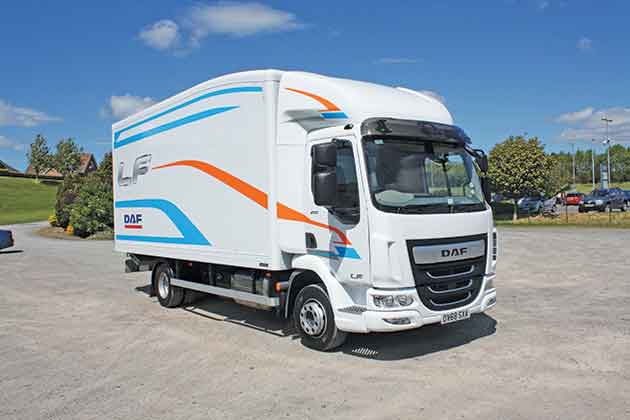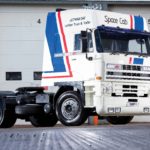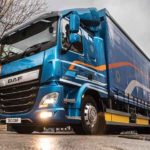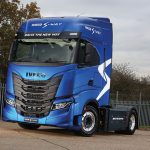
Worried the 7.5 tonner cannot carry enough payload? Many operators are looking to improve productivity by moving up the weight categories, and as Kevin Swallow discovers, the 12 tonner is popular these days.
FOR SHEER product versatility the two axle range has it all, from 7.5 to 18 tonnes GVW there is a variety of engines, cabs and wheelbases.
Since 2010, according to statistics from the Department for Transport, the number of licensed trucks between 7.0 and 8.0 tonnes GVW has fallen by 32% to 102,000 last year. In contrast trucks boasting a GVW above 8.0 tonnes up to 18 tonnes has risen by 7% to 100,000.
There is not enough information to suggest rising popularity of the mid-weights ranges at 10, 12 and 15 tonnes GVW is behind the 7% rise, but those operators no longer operating 7.5 tonners must have gone somewhere.
Of those two axle rigids one in five are fitted with a box van, one in six is a tipper and one in eight is a curtainsided body. At 12 tonnes GVW, the top three are box, curtain and street cleaners/sweepers.
Back in 2017, DAF Trucks introduced a raft of innovations to its LF. This included a new 3.8 litre Paccar engine for a lightweight 7.5 tonner, the LF City, and a revamped exterior and interior ‘aligned with the new CF and XF’. This includes chrome strips on the grille and the new logo panel.
There is no ignoring it, the 12 tonne GVW truck is a more robustly built 7.5 tonner using the same cab, engines and chassis. The LF210, which is Transport News test vehicle, comes with a choice of two engines, Paccar PX-5 and PX-7 and four engine power ratings.
These engines were tweaked in 2016 with new software and optimised heat and air management, which increased the maximum torque of both engines by up to 12% more than previous versions and working 100 to 200 lower revs.
Often badged horsepower ratings are rounded up. In this case, and in a rare moment of accuracy by the manufacturer, the badged horsepower differs by less than 1% from the actual true ratings. On the PX-5 the 180 is actually a true 181hp and the 210, the engine that features in this road test, is 210hp.
Should the operator require more gusto then the PX-7 6.7 litre is available at 230 and 260hp
Let’s concentrate on the 210. The Paccar PX-5 4.5 litre engine is a four cylinder in-line turbocharged diesel with intercooling, which uses exhaust gas recirculation (EGR) and diesel particulate filter (DPF), and selective catalytic reduction (SCR) aftertreatment to achieve Euro 6. It delivers 210hp at 2,300rpm, and 850Nm from 1,200 to 1,500rpm, the previous engine delivered 760Nm between 1,300 and 2,000rpm.
As for the gearbox the standard option is the six speed manual overdrive. Options are twofold; the automated five speed direct top and the AS Tronic six speed overdrive with a manual override (more about that later).
To help improve fuel economy DAF has given the rear axle a new final drive ratio, 3.31, which means the revs at cruising speeds are up to 200rpm lower. The Dutch believe it can deliver a 6% saving in fuel costs.
Post 2017 LF, with rear air suspension, comes standard with advanced emergency braking system, forward collision warning, adaptive cruise control (ACC) and lane departure warning system.
If you go for the day cab then you can choose from 12 wheelbases from 3.05 to 6.70m, select the sleeper cab then you can only select from 10 starting at 3.55m, with the shortest two removed from the options list.
With a day cab, 4.3m wheelbase and full tanks the chassis cab weighs in at 3,743kg. That gives the operator 8,257kg for the bodywork and driver. Choose the sleeper and you’ll add just 120kg to the kerb weight.
Considering you need to add bodywork, DAF has improved its ‘Body Attachment Modules’, which includes specific preparations for the box van with a tail lift (in this case a ‘Ready To Go’ box van added on the Leyland production line), a tanker with subframe or a tipper.
Part of the appeal of a small truck is just how easy they are to drive. Once into D for drive the gearbox makes consistent changes up the box to top gear, and decent power to weight ratio provided a fairly constant speed on the undulating M74. ACC was deployed, and the trucks engines worked happily at 1,500rpm at 56mph.
Set at its highest safety level ACC will generally respond quicker to slow moving vehicles than the driver, who will generally continue to close the gap with the vehicle in front and judge when the time is right to move into an overtaking lane when space permits.
As such, drivers tend to rely on their own sense of spatial awareness to maintain momentum than rely on the ACC, so are more likely to use the standard cruise control. The problem is that with the standard cruise control the driver will deactivate it by touching the brake pedal as they get too close to the vehicle in front and hamper the trucks progress.
Setting ACC at one mark, which allows the driver to get closer to the slower vehicle in front before it kicks in, the truck made decent progress from Carlisle towards Glasgow without the sense of slowing every time it approached a slower vehicle.
DAF suggest this allows the driver to use the cruise control function more often because the truck will only slow rather than deactivate the cruise control and subsequently provide a better fuel economy.
Even though this DAF LF210 is only fitted with the perfunctory exhaust brake the driver can use it to great affect by dropping gears using the plus/minus switch on the transmission control box to the left of the driver’s seat (and not yet relocated to the dashboard). Drop one or two gears to get the revs up towards 2,500rpm in the blue zone and it reduces road speed significantly.
To get the best from the engine brake the driver has to read the road ahead, and as DAF Trucks driver trainer Mandy Wannerton pointed out: ‘Actively using the exhaust brake in most situations also saves the disc brakes from unnecessary wear ensuring they have a longer service life.’
Through Glasgow city centre the 4.3m wheelbase did not provide any real headaches, and the truck was able to remain in its chosen lane most of the time. It needed additional lateral room to manoeuvre left from London Road into Saltmarket, and again turning left from Morrison Street in Laurieston into Paterson Street. Otherwise it coped well.
One area all the manufacturers have focussed on is visibility and namely the lower window in the passenger door for enhanced safety. For DAF this is the ‘vision door’. While the manufacturers are at pains to tell you that will optimise passenger side visibility in urban environments, in truth, it doesn’t. The view is limited and if you put anything in the footwell it is blocked altogether.
What is more the side window is prone to getting dirty. When it’s covered in a thin layer of dirt from the road you can’t see much through it, and if there is external artificial light the dirt blocks most of that brightness making the glass a visual barrier.
That problem is also transposed to the upper window. If dirty and hampering the view to the wing mirror, usually the driver would drop the window but with additional glass in the lower part of the door the driver cannot do that. Instead half the window moves forward, which means visibility can actually be hindered out of both windows of the vision door.
As for the cab interior, the revamp combines down to earth with tasteful. The footwell, engine cover and seat are all dark colours to hide the grime, whereas the upper parts on the walls and above the windscreen are lighter, giving it an airy, spacious feel.
DAF has redesigned its driver information panel and changed the graphics to make messages clearer. For stowage, the passenger seat can be opened up and bags put in, and the back of the central seat can be lowered to reveal cup holders and storage for documents.
With more councils gradually turning city centres into low emission zones, reducing the delivery times and restricting the places and spaces where trucks can unload, you need to consider utilising payload and load space.
If you haven’t considered moving up to a greater GVW spare a thought for the 12 tonner as it might just be the truck for you. The downside is that its legal speed will fall in-line with all heavy commercials that exceed 7.5 tonnes.
The LF210 is a strong specification with a spirited driveline. Those changes made by DAF Trucks work well; it’s got a little extra oomph with the torque and lowering the rev-count and improving the rear axle ratio will always help make it more economical to run.
It is an excellent truck, comfortable, easy to drive and with a strong payload. It might take a little longer to reach the city than a 7.5 tonner but it’ll do a lot more work once it’s there.




